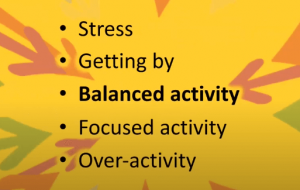How anxious or irritable are you right now? How tired do you feel? Take the coMra Wellness Test to see what your current state of wellness is, and why it matters.
coMra Wellness Test
Our physical wellness is directly connected to our overall state of being. This was established scientifically by Russian Professor L. Kh. Garkavi, after ground-breaking research into the body’s responses to stress and the measured impact of stress on health. Radiant Life Technologies have developed a self-assessment tool based upon the work of Professor Garkavi, who identified and selected 10 key parameters that serve as a measure for overall systemic health.
How Does It Work?
The coMra Wellness Test gives you a “snapshot” of where you are right now, based on ten parameters in the form of questions answered on a sliding scale.

- Activity
- Optimism
- Appetite
- Sleep
- Efficiency
- Stamina
- Anxiety
- Irritability
- Fatigue
- Depression
Based on the rating that you apply for each question, on the coMra Wellness Test result page, you will see:
- Your current state
- Your level of capacity to adapt within your current state
- The main characteristics of this state
- The suggestions for your next step
Your body has several broad states of being, ranging from one of ‘stress’ through ‘balanced activity’ to a state of ‘over-activity’. The ideal state of being is one of ‘balanced activity’.
The state of stress can be characterised by an emotional and mental state that tends towards suppression and depression as well as impaired sleep and poor appetite. Derived from the Latin word stringere, meaning to ‘draw tight’, stress originally referred to physical strain placed on a material object.

Professor Garkavi took the work of Dr Selye to a new level, and her research over the span of 40 years resulted in her being able to directly and consistently link psychological and physiological states. She showed that based on the state of the body, we can then determine our capacity and ability to adapt to life-supportive choices rather than resisting the natural flow of life and well-being.

This test has been designed to assist with increasing your awareness of these 10 basic parameters in your life and their role in your overall well-being.
Come join us as we share this new and exciting tool. It is easy and fun to use and hugely beneficial in supporting you to tune into and make adjustments to your body’s state of wellness.
Watch a short introduction to the wellness test application here or view the full webinar that presents the background research, the wellness test and its application in more detail.
Are you ready to tune in to your current state of being?





